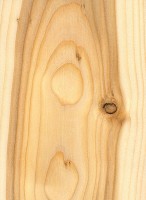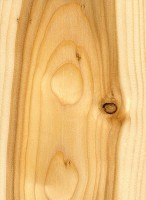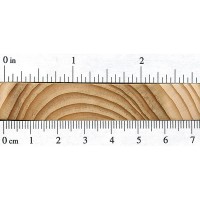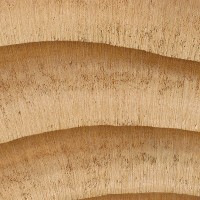 |
Common Name(s): Tamarack, American Larch, Eastern Larch Scientific Name: Larix laricina Distribution: Canada and northeastern United States Tree Size: 50-65 ft (15-20 m) tall, 1-2 ft (.3-.6 m) trunk diameter Average Dried Weight: 37 lbs/ft3 (595 kg/m3) Specific Gravity (Basic, 12% MC): .49, .59 Janka Hardness: 590 lbf (2,620 N) Modulus of Rupture: 11,600 lbf/in2 (80.0 MPa) Elastic Modulus: 1,640,000 lbf/in2 (11.31 GPa) Crushing Strength: 7,160 lbf/in2 (49.4 MPa) Shrinkage: Radial: 3.7%, Tangential: 7.4%, Volumetric: 13.6%, T/R Ratio: 2.0 |
Color/Appearance: Heartwood ranges from yellow to a medium orangish brown. Narrow sapwood is nearly white and is clearly demarcated from the heartwood. Flatsawn sections can exhibit a lot of character and interesting patterns in the growth rings. Knots are common but are usually small.
Grain/Texture: Grain is generally straight or spiraled. Texture is medium to fine with a greasy or oily feel.
Endgrain: Small resin canals, infrequent and variable in distribution; solitary or in tangential groups of several; earlywood to latewood transition abrupt, color contrast high; tracheid diameter medium-small. (Growth rings are generally wider in Tamarack than in Western Larch.)
Rot Resistance: Moderately durable regarding decay resistance.
Workability: Most hand and machine operations produce good results. However, Tamarack is high in silica content and will blunt cutting edges. Also, because of the disparity between the soft earlywood and the hard latewood, sanding can create dips and uneven surfaces.
Odor: No characteristic odor.
Allergies/Toxicity: Although severe reactions are quite uncommon, wood species in the Larix genus have been reported to cause skin irritation, as well as hives and skin lesions. See the articles Wood Allergies and Toxicity and Wood Dust Safety for more information.
Pricing/Availability: Lumber production of Tamarack is very small, and wood is very seldom available commercially. Expect prices to be moderate.
Sustainability: This wood species is not listed in the CITES Appendices, and is reported by the IUCN as being a species of least concern.
Common Uses: Snowshoes, utility poles, posts, rough lumber, boxes/crates, and paper (pulpwood).
Comments: Tamarack is a word from the native Abenaki language, which simply means “wood used for snowshoes.”
None available.








Is it normal that there is purple coloring in the bark of tamarack? The entire length of each board I have is like this. I’m not complaining. Just curious. This is my first time with it so just learning it’s characteristics and havent seen this made mention of at all. I havent noticed it in other species, just this ao far
I used larch for my siding in western Pennsylvania. It’s rot resistant, bug repelling and woodpecker proof. I use it for ask types of outdoor projects as well. I can’t speak highly enough about this species. I’ve attached some example pics. One is of how it looks on a floor. It’s incredibly hard as well for a soft wood.
I heard that Eastern Larch had very good rot resistance, but wasn’t bug resistant. Is this just a wive’s tale or what? I was told like it’s cell structure resists water and it could be left in the ground as a post. Makes sense as it’s a swamp tree. How rot resistant is “moderately” in comparison to something like new growth EWP in terms of years in the ground or something like that.
We moved out to a 100 year old farm this year. Did some yard cleanup that involved pulling out old fence posts. They were spoke shaved tamarack around 4 inches in diameter. most of the fencing in this area was 60 years old. The soil was mostly sand with about 3 inches of topsoil. The post were in really good shape for their age. the majority of decay was in the top 3 inches where the topsoil held more biodiversity. The post had decay down to about 3″ diameter in this area.. In the sandy soil there was no sign… Read more »
Tamarack does have very good rot resistance especially in wet environments. Fishing weirs and fishing wharves are good applications. A friend of mind does repair work on fishing wharves. He has said that the only remaining original fender piles from wharf construction are tamarack. They’re so durable that they’re just starting to change them out now (others species were needing changed 20+ years ago) as the boats have rubbed them thin from the changing tides or the top starts to get soft. But when they pull them from the sea everything underwater is still in great shape. I have milled… Read more »